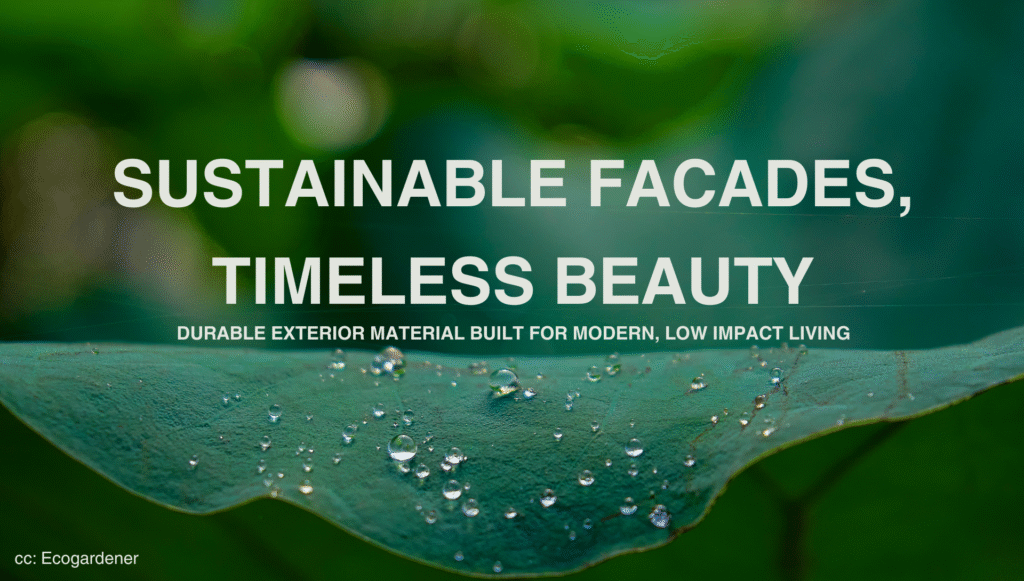As homeowners rethink the way their homes interact with climate, environment, and long-term maintenance, exterior wall tiles are emerging as one of the most important facade upgrades in modern sustainable living.
What used to be a purely functional surface, painted siding or simple cladding has evolved into a design-forward, eco-conscious, and highly durable architectural element.
Whether building new or renovating an existing home, upgrading the landscape, more people are shifting toward wall tile facades that offer long-term resilience, lower environmental impact, and natural aesthetics that age beautifully.
The Rise of Eco-Friendly Facades
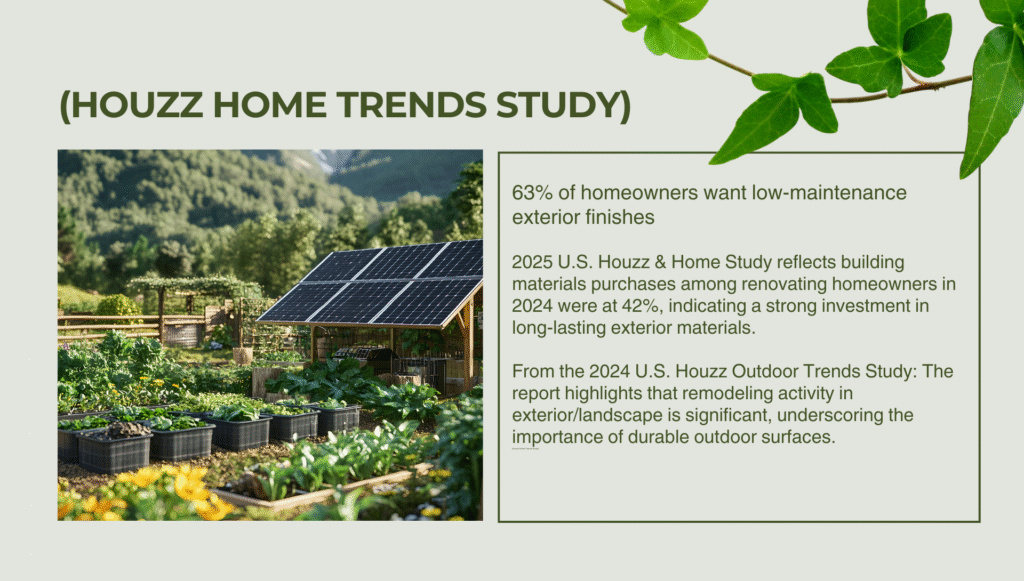
Sustainable building is no longer a niche interest. It’s becoming mainstream.
A growing number of homeowners now prioritize materials that last longer, consume fewer resources, and perform better in changing environmental conditions.
Recent design and housing reports reveal:
- Searches for “eco-friendly exterior materials” increased significantly across home platforms (Pinterest Trend Data).
- Long-life materials such as porcelain and ceramic tiles reduce lifetime emissions by up to 50% compared to paint or wood siding (materials lifecycle research).
This shift is driving interest in resilient facade tiles especially with the likes of OUTERclè outdoor wall tiles that support a more eco-conscious lifestyle.
From a sustainability standpoint, OUTERclè embodies the philosophy that the most eco-friendly materials are the ones that endure, further exemplifying the shift toward surfaces that are not only durable and visually expressive but also aligned with the principles of mindful, low-impact living.
Why Durable Facade Tiles Are a Smart Sustainable Choice
Today’s homeowners want materials that work as hard as their homes do. Wall tile facades offer an unmatched blend of performance and sustainability.
1. Lower Lifetime Environmental Impact
Durability isn’t just a performance feature; it’s a sustainability strategy. High-quality exterior tiles are designed to last 40 years or more, which dramatically reduces the environmental footprint of a home’s facade over its lifespan.
Unlike wood siding or paint that must be refreshed every few years, tiles don’t require constant replacement, sanding, refinishing, or chemical treatments.
This longevity means:
- far less construction waste
- minimal use of new raw materials
- fewer transportation emissions from delivering replacement products
- reduced reliance on paints, sealers, or harsh chemicals
In other words, every decade your facade doesn’t need replacing is a decade of resources saved.
When you multiply that across millions of homes, durable tiles become one of the most environmentally responsible choices available in exterior design today.
2. Weather Proof Strength
Exterior walls face some of the toughest environmental stressors, and not all materials are designed to cope with them. That’s where high-performance porcelain and ceramic facades stand out.
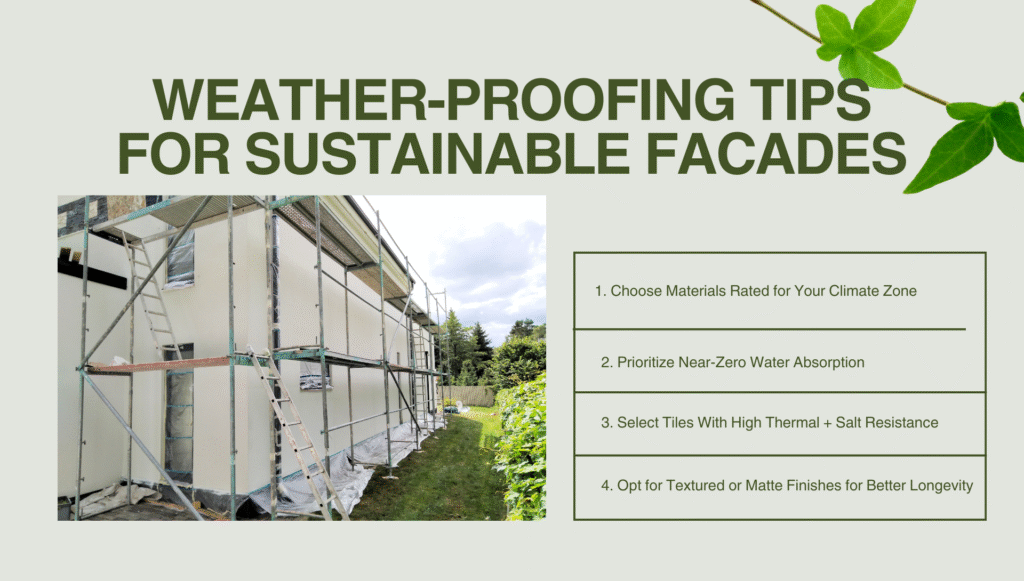
They’re engineered specifically to tolerate extreme and fluctuating weather, making them a reliable choice for sustainable homes that need to perform year after year.
These advanced facade tiles can endure:
- Intense UV exposure They don’t fade, bleach, or weaken under strong sunlight, even in hot, dry regions. Their pigments and surface finishes remain stable, preserving curb appeal for decades.
- Heavy rainfall and constant moisture With near-zero water absorption, porcelain tiles don’t swell, rot, peel, or grow mold. This makes them ideal for humid climates, monsoon regions, and garden-rich homes.
- Severe freeze–thaw cycles While many materials crack when trapped moisture expands, porcelain maintains its integrity through constant temperature swings crucial in colder climates.
- Coastal salt air Salt corrosion is a real threat to exterior materials near the ocean. Porcelain and ceramic facades are naturally salt-resistant, ensuring long-term structural and aesthetic stability.
- Heat waves and rapid thermal changesThese tiles can withstand extreme temperatures without warping or losing strength. Their fire resistance is another bonus for regions affected by rising heat and wildfire risks.
In short, tougher climates demand tougher materials, and exterior-rated tiles are built exactly for this purpose. They protect the home’s envelope, reduce long-term repairs, and offer a durable, eco-friendly alternative to materials that degrade under environmental pressure.
For sustainable homes looking to minimize lifetime maintenance and maximize resilience, high-performance facade tiles deliver unmatched reliability.
3. Minimal Upkeep
Unlike paint, wood, or composite siding, facade tiles offer true low-maintenance living
One of the biggest advantages of exterior wall tiles is how effortlessly they perform over time. While materials like wood, paint, and composite siding require ongoing upkeep, facade tiles are engineered to stay beautiful with almost no intervention.
This makes them one of the most sustainable choices for modern homes reducing both environmental impact and long term homeowner costs.
Here’s what sets them apart:
- They never need sealingMany exterior surfaces require yearly or bi-annual sealing to prevent water damage. Tiles, especially porcelain, have near-zero porosity. They’re naturally resistant to moisture without any chemical treatments.
- They never need repaintingPaint fades, chips, peels, and discolors in sunlight. Wood stains break down over time. Tiles retain their color and finish for decades, even in strong UV conditions eliminating the need for constant repainting cycles.
- They resist mold, algae, and organic growthHumid or rainy climates can wreak havoc on wood and composite materials. Tiles don’t absorb water, so they don’t become breeding grounds for mold, mildew, moss, or algae.
- They clean easily with plain waterIn most cases, a simple hose rinse or mild soap is all that’s needed. No heavy chemicals, no pressure washing, no sanding, just straightforward cleaning that aligns with eco-friendly living.
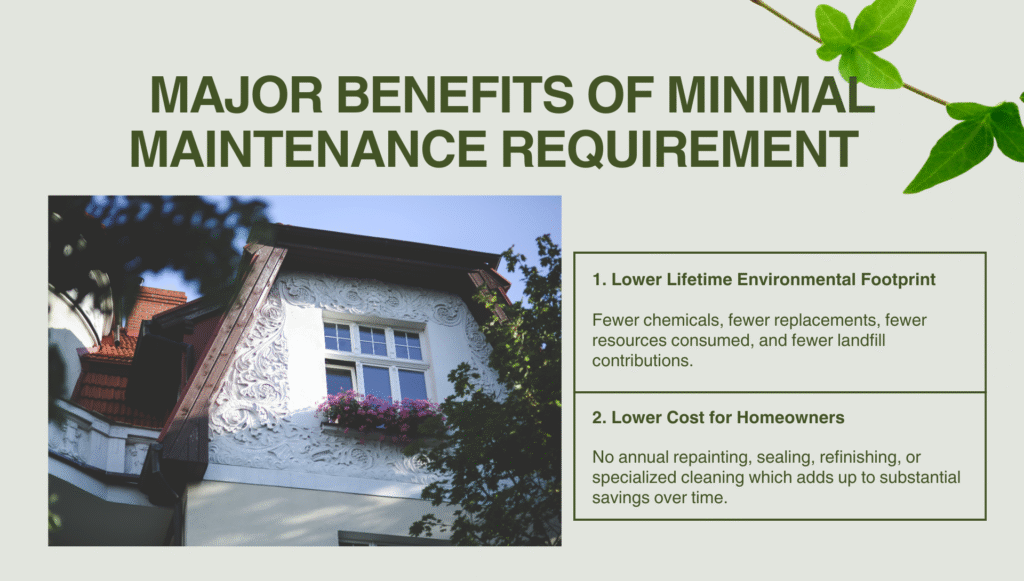
In short, high durability = lower environmental impact + lower long-term cost, making facade tiles one of the smartest and most sustainable exterior material choices for modern homes.
Wall Tile Trends Shaping Sustainable Homes
1. Nature Inspired Textures & Tones
One of the most noticeable design shifts in modern facades is the return to natural, earth-toned color palettes.
Instead of high-gloss finishes or stark whites, homeowners are choosing hues that feel grounded, organic, and deeply connected to the surrounding landscape. These softer tones not only elevate curb appeal with natural hardscaping but also create a sense of calm and continuity between the home and nature.
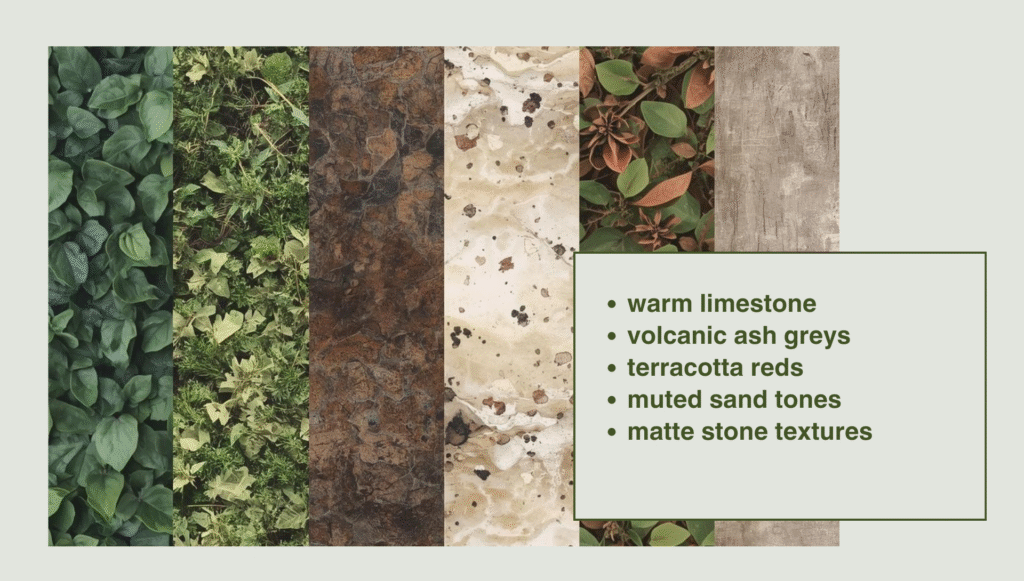
For EcoGardener readers, these palettes make perfect sense: they complement raised beds, pollinator gardens, native landscaping, and outdoor living zones where greenery, soil, stone, and sunlight are the main design elements.
2. Large Format & Minimal Join Facades
One of the strongest trends in modern exterior design is the move toward large format facade tiles. These oversized panels create a clean, seamless look that feels elevated, contemporary, and intentionally minimal.
For sustainable homes, they offer both visual and functional advantages that make the facade more efficient and easier to maintain over time. Modern homes are increasingly embracing bold, oversized shapes such as:
- 24×48-inch slabs Ideal for modern, minimalist exteriors with a smooth, monolithic look.
- Vertical porcelain planks Create the illusion of height and work beautifully for narrow or compact homes.
- 32×32 square formats Offer a balanced, architectural grid that feels refined and sculptural.
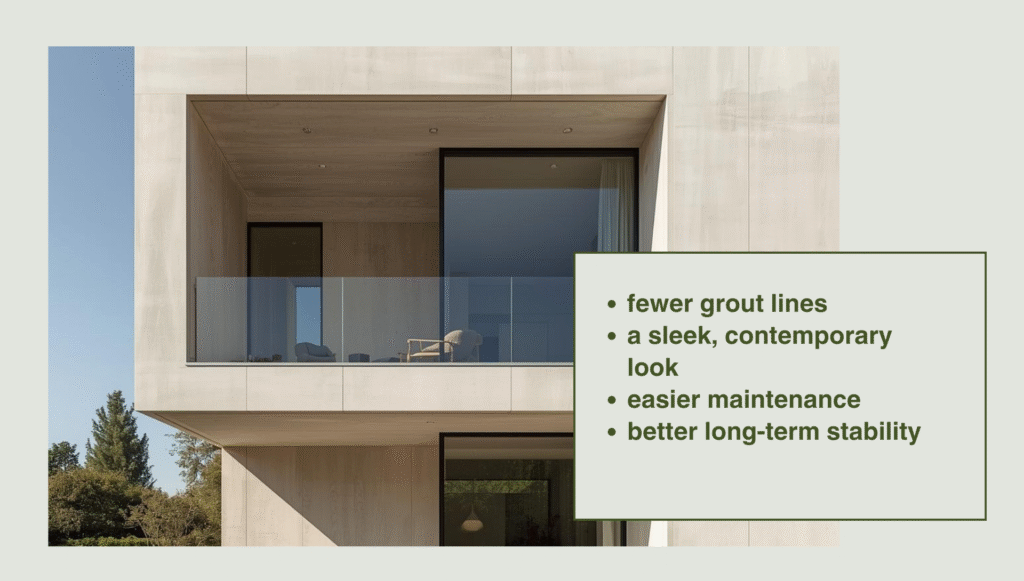
For EcoGardener readers, this trend matches the philosophy of thoughtful simplicity design that is functional, low-impact, and visually calming.
3. Sculptural & Textured Facade Surfaces
Contemporary homes are moving beyond flat walls with sculptural, light-catching textures
One of the most exciting shifts in facade design is the move away from smooth, featureless walls toward textured, dimensional surfaces that add depth, shadow, and character. Today’s most sought-after textures include:
- Ribbed panels: Long, rhythmic lines that create a sense of verticality and elegance. They add a subtle sculptural rhythm to the facade, making even simple volumes feel refined. Academy House in London uses ribbed terra-cotta panels to create a textured, vertical rhythm and refined architectural expression.
- Fluted clay tiles: Inspired by handcrafted pottery and ancient architectural forms, fluting adds warmth, tactility, and a timeless artisanal quality. It bridges the gap between modern minimalism and traditional craftsmanship.
- Carved geometric surfaces: Tiles etched with angular or curved patterns create graphic interest while maintaining a quiet, architectural presence.
The Sustainability Angle
- Textured tiles also support eco-design in subtle ways:
- Their matte, tactile surfaces often reduce light glare and heat reflection.
- Clay and porcelain textures are long-lasting and low-maintenance.
- Handcrafted appearances evoke slower, more intentional making practices.
- They allow homeowners to achieve high-impact design without resorting to paints or chemical surface finishes.
For homeowners who want a facade that looks sophisticated without sacrificing sustainability, textured and sculptural tiles offer the perfect balance.
4. Terracotta & Clay Revival
As homeowners move away from overly processed materials and gravitate toward earth-derived finishes, terracotta and clay-based facade tiles are experiencing a well-deserved resurgence. These materials have been used in architecture for centuries, yet they feel more relevant than ever in an age of sustainability, climate awareness, and slow-crafted design.
Terracotta and clay tiles bring a unique set of benefits that align beautifully with modern eco-conscious building:
- Sustainable roots
Made from natural clay and minerals, terracotta requires little processing compared to cementitious or synthetic cladding. Its manufacturing carries a relatively low embodied energy, especially when produced locally or in efficient kilns. Homeowners are increasingly choosing materials that honor the earth rather than burden it and clay fits seamlessly into that ethos.
- Breathable surfaces
Clay tiles naturally regulate temperature and moisture, allowing the facade to “breathe.” This contributes to healthier wall systems, reduced trapped humidity, and improved performance in both hot and cool climates. In sustainable design, breathability is key to long-lasting, low-maintenance envelopes.
- Long-lasting, time stable color
Unlike painted surfaces that fade or peel, terracotta’s pigment runs through its entire body. Its color comes from the earth itself; not coatings making it UV-stable and weather-resistant. Over time, terracotta develops a gentle patina that adds charm rather than deterioration.
- Artisan character
Terracotta tiles carry visible evidence of craft subtle tonal variations, hand-pressed textures, or the impression of the firing process. This character adds warmth and soul to exteriors in a way mass-produced siding simply can’t replicate. Even machine-extruded clay tiles retain a natural richness and variability.
5. Stone-Look Surfaces Without the Quarrying Impact
Porcelain tiles that mimic limestone, basalt, travertine, or slate offer the beauty of stone with a far gentler environmental footprint
One of the strongest shifts in sustainable facade design is the move toward stone-look porcelain tiles materials that capture the timeless elegance of natural stone without the heavy ecological cost of quarrying, cutting, and transporting actual rock.
Thanks to advanced manufacturing, these tiles achieve remarkable levels of realism, from subtle veining and mineral depth to textured, matte finishes that feel almost indistinguishable from the real thing.
Here’s why they’re becoming one of the top choices for eco-conscious architects and homeowners:
- High visual realismModern porcelain technology allows for incredibly detailed surface graphics and authentic textures. Whether you love the soft gradients of limestone, the dramatic striations of basalt, or the organic warmth of travertine, stone look porcelain delivers the same visual impact, often with even better consistency and color stability over time.
- Long lifespanUnlike natural stone, which can stain, weather, or erode depending on climate, porcelain remains stable for decades. It is non-porous, UV-resistant, frost-proof, and fire-safe, making it ideal for exterior walls that face intense environmental exposure. This longevity directly supports sustainability: fewer repairs, fewer replacements, far less waste.
- Minimal ecological extractionQuarrying natural stone is one of the most resource-intensive processes in the building industry. In contrast, stone-look porcelain uses responsibly sourced clay and minerals, often includes recycled content, and eliminates the need for disruptive mining. It provides the look of stone while dramatically lowering land disturbance and material extraction impacts.
The sustainable solution for stone lovers
For homeowners, stone-look porcelain offers the best of both worlds: the grounded, timeless beauty of natural rock without the ecological strain.
It blends effortlessly with gardens, native plants, wooden elements, and earth-driven outdoor palettes creating facades that feel rooted in nature while remaining eco-responsible. And because porcelain is so durable and maintenance-free, its environmental footprint stays low throughout its entire life cycle.
In short, stone-look porcelain gives you the elegance of real stone and the sustainability that modern homes demand, a combination that’s driving some of the biggest facade trends today.
Conclusion
Exterior design is moving toward durability, authenticity, and sustainability.
With consumers demanding materials that perform in extreme climates while elevating curb appeal, façade tiles offer one of the strongest long-term returns for modern, eco-conscious homeowners.
Brands like OUTERclè are helping define this new era of mindful materials with facade collections that combine durability, craftsmanship, and environmental responsibility.

